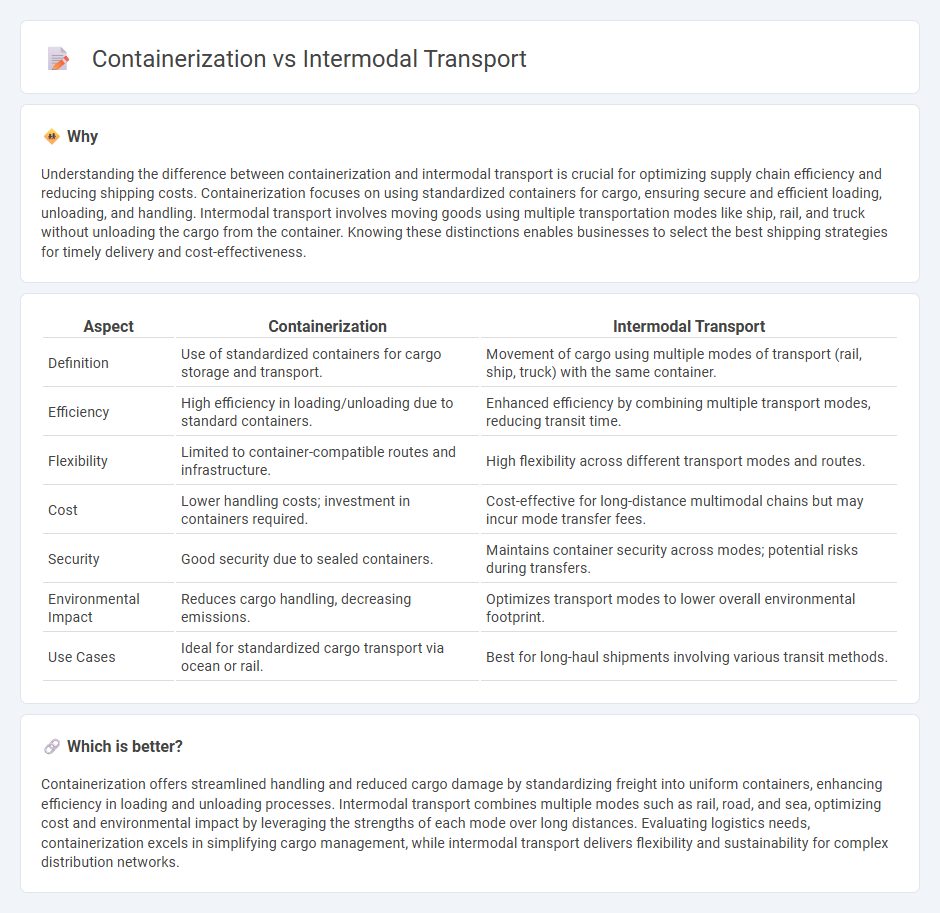
Containerization revolutionizes logistics by standardizing cargo transport using uniform containers, enhancing efficiency and security. Intermodal transport leverages multiple transportation modes--such as ships, trains, and trucks--using these containers to optimize route flexibility and reduce transit times. Explore the advantages and applications of containerization versus intermodal transport to improve supply chain performance.
Why it is important
Understanding the difference between containerization and intermodal transport is crucial for optimizing supply chain efficiency and reducing shipping costs. Containerization focuses on using standardized containers for cargo, ensuring secure and efficient loading, unloading, and handling. Intermodal transport involves moving goods using multiple transportation modes like ship, rail, and truck without unloading the cargo from the container. Knowing these distinctions enables businesses to select the best shipping strategies for timely delivery and cost-effectiveness.
Comparison Table
| Aspect | Containerization | Intermodal Transport |
|---|---|---|
| Definition | Use of standardized containers for cargo storage and transport. | Movement of cargo using multiple modes of transport (rail, ship, truck) with the same container. |
| Efficiency | High efficiency in loading/unloading due to standard containers. | Enhanced efficiency by combining multiple transport modes, reducing transit time. |
| Flexibility | Limited to container-compatible routes and infrastructure. | High flexibility across different transport modes and routes. |
| Cost | Lower handling costs; investment in containers required. | Cost-effective for long-distance multimodal chains but may incur mode transfer fees. |
| Security | Good security due to sealed containers. | Maintains container security across modes; potential risks during transfers. |
| Environmental Impact | Reduces cargo handling, decreasing emissions. | Optimizes transport modes to lower overall environmental footprint. |
| Use Cases | Ideal for standardized cargo transport via ocean or rail. | Best for long-haul shipments involving various transit methods. |
Which is better?
Containerization offers streamlined handling and reduced cargo damage by standardizing freight into uniform containers, enhancing efficiency in loading and unloading processes. Intermodal transport combines multiple modes such as rail, road, and sea, optimizing cost and environmental impact by leveraging the strengths of each mode over long distances. Evaluating logistics needs, containerization excels in simplifying cargo management, while intermodal transport delivers flexibility and sustainability for complex distribution networks.
Connection
Containerization revolutionizes logistics by standardizing cargo units, enabling seamless transfer between ships, trucks, and trains within intermodal transport systems. Intermodal transport leverages containerization to optimize supply chain efficiency, reduce handling costs, and minimize shipping times across global networks. This connection facilitates reliable, flexible, and cost-effective movement of goods worldwide, enhancing global trade scalability.
Key Terms
**Intermodal Transport:**
Intermodal transport integrates multiple modes of transportation, such as rail, ship, and truck, to move goods efficiently without handling the freight itself when changing modes, thereby reducing transit times and costs. It enhances supply chain flexibility and sustainability by optimizing route segments and minimizing road congestion and emissions. Discover more about how intermodal transport transforms global logistics and enhances freight movement.
Transshipment
Intermodal transport streamlines cargo movement by using multiple modes of transportation--such as ships, trains, and trucks--without handling the freight itself when changing modes, reducing transshipment time and cost. Containerization enhances this process by standardizing cargo units into uniform containers, simplifying loading, unloading, and transfers at transshipment hubs worldwide. Explore how integrating intermodal transport with containerization revolutionizes global supply chains and improves efficiency.
Multimodal Integration
Intermodal transport enhances multimodal integration by efficiently combining rail, road, and sea modes, reducing transit times and operational costs. Containerization standardizes cargo handling through uniform containers, facilitating seamless transfers between different transport modes while ensuring cargo protection and tracking. Explore how multimodal integration and containerization drive global supply chain efficiency and sustainability.
Source and External Links
What Is Intermodal Transportation? History, Benefits ... - Intermodal transportation entails moving goods in a steel container using two or more modes of transport such as ships, rail, aircraft, and trucks, enabling efficient freight transfer without unpacking cargo between modes.
Intermodal freight transport - Intermodal freight transport uses multiple transportation modes (rail, ship, aircraft, truck) to move freight in a container or vehicle without handling the freight itself between modes, which enhances security, speeds delivery, and reduces costs, especially over long distances.
What is intermodal - Intermodal transport refers to the movement of goods internationally using several transport methods such as ocean freight, air freight, rail, and trucking without handling the goods themselves when changing modes, ensuring efficient, seamless cargo transfer.
 dowidth.com
dowidth.com